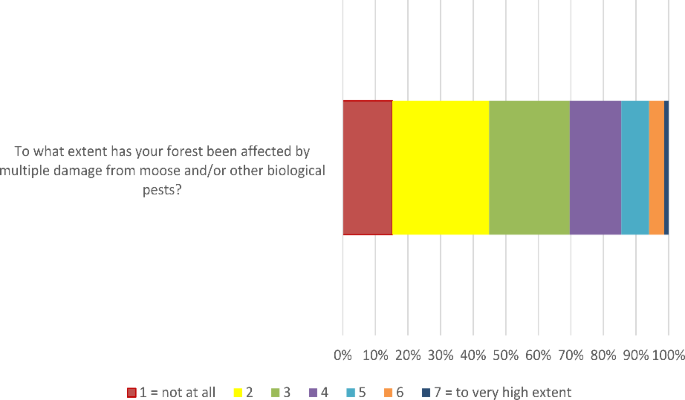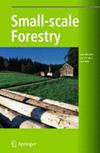瑞典北部非工业私人森林所有者关于森林损害的知识和森林管理偏好
IF 1.8
3区 农林科学
Q2 FORESTRY
引用次数: 0
摘要
在瑞典北部,大片森林地区受到驼鹿、真菌、甲虫和其他生物害虫的广泛破坏。对于非工业私有森林(NIPF)所有者来说,这不仅在经济方面,而且在生物多样性和舒适价值的丧失方面,导致了巨大的价值损失。因此,一些研究项目正在进行中,以开发新的造林方法和其他措施,以减少损害。然而,这些措施的成功实施往往取决于森林所有者的意愿和知识。因此,本研究的目的是阐明NIPF所有者对森林损害的了解,以及他们对可能减轻损害情况的森林管理备选方案的偏好。数据通过问卷收集,随机抽取瑞典北部1177名NIPF车主,回复率为31% (n = 368)。结果表明,19%的NIPF所有者不知道自己森林的当前破坏情况。此外,NIPF车主认为,除了驼鹿造成的损害外,他们自己识别损害的知识相当有限。关于未来的管理选择,许多人对避免在适当地区砍伐树木持积极态度,而许多人对采用落叶松和黑松等替代树种持消极态度。该研究的结论是,显然需要向NIPF所有者提供有关森林破坏的信息和教育,但在接触所有类型的所有者方面也存在挑战。本文章由计算机程序翻译,如有差异,请以英文原文为准。

Non-industrial Private Forest Owners’ Knowledge and Forest Management Preferences Regarding Forest Damage in Northern Sweden
Abstract In northern Sweden, large forest areas are affected by extensive damage caused by moose, fungi, beetle and other biological pests. For non-industrial private forest (NIPF) owners this leads to large losses of value, not only in economic terms but also in the form of loss of biodiversity and amenity values. Therefore, several research projects are underway to develop new silvicultural methods and other measures to reduce damage. However, a successful implementation of these will often depend on the willingness and knowledge of the forest owners. The objective of this study was, therefore, to elucidate NIPF owners’ knowledge about forest damage and their preferences regarding forest management alternatives that potentially could mitigate the damage situation. Data were collected through a questionnaire that was distributed to a random sample of 1,177 NIPF owners in northern Sweden, and the response rate was 31% ( n = 368). The results show that 19% of the NIPF owners did not know the current damage situation in their own forest. In addition, NIPF owners judged that their knowledge to identify damage themselves is quite limited, except for damage caused by moose. Regarding future management options, many were positive towards avoiding clear-cuts in suitable areas, while many were negative towards implementing alternative tree species such as larch and lodgepole pine. The study concludes that there is a clear need to inform and educate NIPF owners about forest damage, but also that there will be challenges in reaching all types of owners.
求助全文
通过发布文献求助,成功后即可免费获取论文全文。
去求助
来源期刊

Small-Scale Forestry
FORESTRY-
CiteScore
3.10
自引率
6.70%
发文量
39
审稿时长
>12 weeks
期刊介绍:
Emerging from discussions within IUFRO’s Small-scale Forestry group, Small-scale Forestry was originally published as Small-scale Forest Economics, Management and Policy in 2002, with a view to providing an international forum for publishing high quality, peer-reviewed papers on pure and applied research into small-scale forestry. Although of particular interest to the global research community, the journal is also relevant to both policy makers and forest managers.
The scope of the journal is necessarily quite broad, given the range of issues relevant to small-scale forestry. These include the social, economic and technical dimensions of farm, family, non-industrial, agro- and community forestry. Papers are accepted on the basis that they relate specifically to forestry at this scale, and that they are based on high quality research using accepted quantitative and/or qualitative methodology.
Empirical, theoretical, modeling, and methodological papers are all welcome. The following research areas are particularly relevant to the journal:
-the role of small-scale forestry in rural development-
financial modeling and decision support systems-
enhancing return from non-wood products-
social impacts of small-scale forestry-
marketing, forest co-operatives and growers organizations-
role and effectiveness of government support and subsidies-
innovative research techniques-
education and extension-
certification-
silvicultural, wood harvesting and processing techniques and technologies-
impediments to small-scale forestry development-
monitoring socio-economics-
forest management behaviour and timber supply
 求助内容:
求助内容: 应助结果提醒方式:
应助结果提醒方式:


